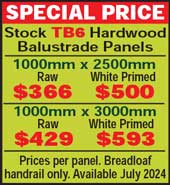15. ARCHES AND BRACKETS
WHAT STYLES OF ARCHES ARE AVAILABLE?
Timber arches were traditionally used to provide visual accents to long passages, divide larger rooms or define the family areas from the rooms used by visitors. Many old houses were built with decorative screens or arches in entrance halls and other rooms, which have often been removed or altered over the years. Their restoration will help to revive the character of the interior of a house. Arches are generally in one of three styles:
Georgian.
Georgian archways generally pre-date the turn of the 20th Century and were simple timber reconstructions of classical masonry arches.
Federation/Bungalow.
Federation style archways are typically vertical timber slats within a curved frame, progressively becoming simpler, straighter and more angular as the Californian Bungalow influence was felt.
Art Nouveau.
Art Nouveau arches were popular in the Edwardian period and typically involved elaborate curvilinear fretworks and asymmetrical designs.




WHERE AND HOW ARE THEY INSTALLED?
Archway openings were traditionally formed exactly the same as doorway openings. They were lined with jambs and had architraves fitted both sides. They were usually constructed the same height as all other openings to a height of approx 2550mm. The arches themselves were then simply skew nailed into position. These days "no more nails" adhesive is more common but the positioning and lining details should be duplicated for the best result. For wider openings the arch is split in the centre and an extension piece is added to the width required. The joints are covered by the keyblocks. There are a range of extensions piece designs available to individualize the arch or match other details pre existing in the house.
WHAT ARE THEY MADE OF?
Woodworkers make arches in a variety of materials for different applications. For flush style arches that are to be painted, laser cut 32mm MDF is preferred as it will not delaminate. Special care must be taken with the fixing of MDF as nails will usually split the material. Adhesive fixing is preferred. For rebated style arches, Woodworkers carry Pacific Maple arches in stock in most designs as it closely approximates the look of the Queensland Maple which was used in many original arches. We also custom manufacture in Red Cedar where clear finishing is required or where weather exposure is an issue. For all external applications, the durability of cedar is essential.
WHAT'S TO KNOW ABOUT VERANDAH BRACKETS?
Decorative Verandah Brackets or 'sweeps' are traditionally used to embellish house facades. Chronologically, brackets only became popular from the 1880's with many of the original designs serving for many decades. The fretworked foliage designs typical of the colonial era were occasionally interlaced with sinuous art nouveau patterns on more avant garde houses. In the early twentieth century, simpler more geometric brackets became most common with larger, more vertical designs being in vogue from the 1920's. Brackets serve no structural purpose but are exposed to continual weather and therefore require to be made of durable material. For over 80 years Woodworkers has been cutting brackets in red cedar or maple. We cut them one at a time by hand in the traditional way using offcuts from our joinery operations. Consequently cutting brackets to match existing examples simply requires the provision of an original bracket or a cardboard template. Most brackets are 32mm thick but this can be varied if required. Our brackets are more durable, authentic & cheaper than laser cut pine alternatives.
HOW SHOULD THEY BE INSTALLED?
Until the late 1920s verandah brackets formed part of a suite of mouldings and fretworks atop each column that served to accentuate and decorate the verandah 'skirts' of the cottage. Columns were commonly stop chamfered between the handrail and the collar moulds. A short space above the collars was the crown moulds which provided the seat for the fretworked verandah brackets. Woodworkers carry precut collar and crown moulds for 100 x 100 columns and has lengths of the same moulds for other size columns. Always thoroughly paint verandah brackets before fixing them so that they are fully sealed even on their concealed faces. They are best fixed with galvanised screws or zinc coated gun nails. From the latter 1920s, verandah brackets grew larger and extended down the columns eliminating the use of collar and crown moulds. Occasionally the sweeps formed part of, or were incorporated into full verandah arches that fully framed the lintels between columns. Verandah brackets fell from favour in the mid 1930s as buildings generally became more austere. Brackets were often removed during modernisations but the scars left behind can give a clue to the size and positioning of the original column decoration.

Perspective view of Cottage Pedestal Arch. PA1 S
Colonial houses built in the late Nineteenth and early Twentieth Century typically used ornate timber pedestal arches and grilles to divide living spaces. The Woodworkers' Company builds arches which replicate measured originals. They are either paint-grade MDF or, where varnishing is preferred Red Cedar or Maple are used. For renovations or new developments we are always ready to build designs that blend comfortably with the architectural style or meet particular specifications.
HALLWAY ARCHES


Caledonian Hallway Arch.
Width 1220 mm. Drop 1050 mm. Thickness 32 mm. Tapered keyblock or Turned Finial available. HA9.

Federation Hallway Arch.
Width 1220 mm. Drop 910 mm. Thickness 32 mm.Tapered keyblock or Turned Finial available. HA6.


Beaux Art Hallway Arch.
Width 1000 mm Drop 910 mm Thickness 32 mm Tapered keyblock or Turned Finia available. HA8.

Tulip Scroll Hallway Arch.
Width 1220 mm. Drop 910 mm. Thickness 32 mm. Tapered keyblock or Turned Finial available. HA7.

Inter War Elliptical Archway.
Width Custom made to suit opening. Drop 1725 mm. Thickness 32 mm. Major Pickets 70 x 19. Minor Pickets 44 x 19. HA15.

Fretwork Hallway Arch.
Width 1000 mm. Drop 1025 mm. Thickness 32 mm. HA24.
Custom cut to your sizes.

Keyhole Hallway Arch.
Width 1080 mm. Drop 1300 mm. Thickness 32 mm. Turned Finial available. HA10.

Edwardian Hallway Arch.
Width 900 mm. Drop 700 mm. Thickness 32 mm. HA16.
Custom made to your sizes in MDF & cedar.

Georgian Elliptical Hallway Arch.
Shown with keyblock and crown moulding. HA20.

Edwardian Room Division Arch.
Drop 700 mm. Thickness 32 mm. HA17.
VERANDAH BRACKETS
1800 to 1900: Queensland Colony Brackets.

vb31
200 x 315

vb14
205 x 390

vb15
255 x 278

vb5
440 x 390

vb24
342 x 338

vb10
385 x 330

vb22
305 x 310

vb21
289 x 305

vb28
450 x 300

vb12
290 x 290

vb1
255 x 360

vb9
345 x 325

vb18
242 x 373

vb2
200 x 405

vb32
160 x 250

vb110
250 x 430

vb113
235 x 395

vb117
237 x 395

vb115
266 x 300

vb40
230 x 440
1895 to 1914: Art Nouveau Brackets.

vb20
300 x 500

vb34
294 x 450

vb6
250 x 390

vb11
290 x 297

vb35
600 x 260

vb106
450 x 360

vb116
300 X 450
1900 to 1918: Federation Pre World War I Brackets.

vb23
400 x 370

vb13
283 x 283

vb4
261 x 322

vb25
275 x 275

vb17
205 x 400

vb33
208 x 201

vb3
340 x 336

vb30
290 x 390

vb114
355 x 282

vb39
242 x 392

vb29
302 x 500

vb8
202 x 323

vb112
400 x 400

vb104
420 x 295
1920 to 1935: Pre World War II Brackets.

vb19
300 x 310

vb36
250 x 380

vb27
600 x 245

vb37
330 x 260

vb102
270 x 200

vb16
600 x 300

vb105
406 x 355

vb7
918 x 290

vb38
910 x 290

vb26
300 x 230

vb101
320 x 300

vb108
600 x 443

vb109
320 x 300

vb103
325 x 225
Eaves and Shelf Brackets.

vb80 208 x 200

vb81 193 x 187

vb82 206 x 148

vb83 190 x 97

vb84 150 x 156

vb85 117 x100

vb86 181 x 150

vb87 250 x 190

Verandah Archways.
Cut from solid timber to suit openings for internal and external applications. Circular and elliptical profiles shown.

Fretworked Verandah Archways.
Cut in Weathertex with solid timber curved bottom rail.


1920's Curvilinear Design.
Symmetrical layout - rebated construction. Height and width adjustment possible to suit each application. PA4-S.
Pedestal Height 1040 mm

Cottage Design.
Symmetrical layout - rebated construction. Height and width adjustment possible to suit each application. PA1-S.
Pedestal Height 1040 mm

Cottage Assymetrical Design.
Height and width adjustment possible to suit each application. PA1-A.
Pedestal Height 1040 mm

1930's Bungalow Pedestal Arch.
Symmetrical layout shown - rebated construction. Asymetrical layout available. Height and width adjustment possible to suit each application. PA5.
Pedestal Height 1040 mm

1920's Filigree Pedestal Arch.
Symmetrical layout shown - flush construction. Height and width adjustment possible to suit each application. PA3.
Pedestal Height 1040 mm

1920's Filigree Assymetrical Arch.
Height and width adjustment possible to suit each application. PA3 A.
Pedestal Height 1040 mm

Turned Column Room Division Screen.
Symetrical layout. Height and width adjustable to suit each application. PA6. Custom cedar only. Average Height required 2550 mm.

Grand Foliage Pedestal Arch.
Symetrical layout, rebated construction. Height and width adjustment possible to suit each application. PA7.
Custom cedar only. Standard Height 2400 mm. Pedestal Height 1040 mm

1920's Tulip Scroll Pedestal Arch.
Symmetrical layout shown - flush construction. Asymetrical layout available. Height and width adjustment possible to suit each application. PA2.
Pedestal Height 1040 mm


The leg of the arch or extension piece can be trimmed back to suit the width of the opening and the joint is concealed behind the keyblock.









